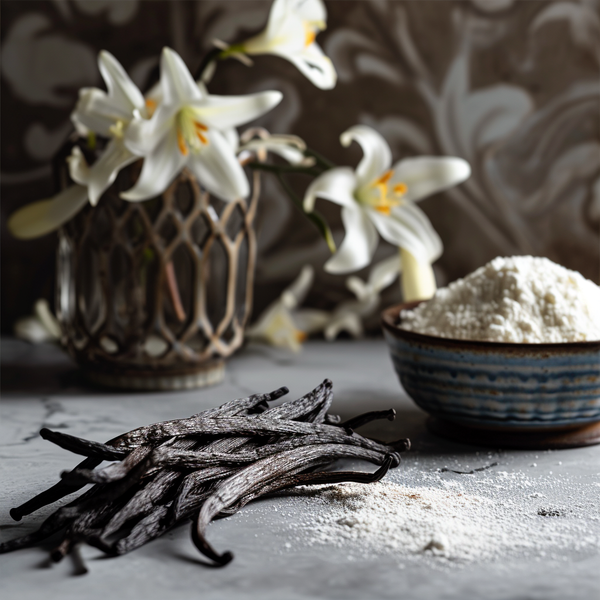
Vanilla
Vanilla is a highly valued and versatile flavoring derived from the pods (or beans) of the vanilla orchid. Its sweet, floral aroma and complex flavor profile make it a favorite in both savory and sweet culinary applications. Here's how vanilla is used in cooking:
Baking:
Vanilla is a staple in baking, used in cakes, cookies, pastries, and bread. It enhances the flavors of other ingredients and adds a warm, comforting aroma.
Desserts:
Vanilla is key in many desserts, including custards, puddings, ice creams, and mousses. It provides a subtle sweetness and depth of flavor that complements a wide range of ingredients.
Sauces and Syrups:
Vanilla-infused sauces and syrups are used to flavor desserts like fruit salads, pancakes, waffles, and various pastries. It adds a rich aroma and taste to these sweet toppings.
Beverages:
Vanilla is used to flavor beverages, including smoothies, milkshakes, coffee, tea, and cocktails. It adds a sweet, aromatic note to drinks.
Savory Dishes:
While less common, vanilla can be used in savory dishes, such as sauces for seafood or poultry, where it adds an unexpected sweetness and aroma that can elevate the dish.
Infusions:
Vanilla beans or extract can be infused into creams, milks, and other liquids to impart flavor in dishes like panna cotta, crème brûlée, and custard-based desserts.
Chocolate and Confectionery:
Vanilla complements the flavor of chocolate in confectionery, truffles, and chocolate bars, balancing the bitterness and enhancing the chocolate's depth.
Preserves and Jams:
A hint of vanilla can be added to fruit preserves and jams to enhance the natural sweetness and flavor of the fruit.
Aromatics:
Vanilla is used in aromatic applications, such as in sugar or salt infusions, where it imparts its fragrance and subtle flavor to the ingredients.
Vanilla Extract and Vanilla Paste:
Vanilla extract, made by soaking vanilla beans in alcohol, is a convenient way to add vanilla flavor to a wide range of dishes. Vanilla paste, which includes the seeds from the vanilla pod, offers a more intense vanilla flavor and visual appeal with the specks of vanilla seeds.
When using vanilla in cooking, it's important to choose the right form for the recipe, whether it's whole beans, extract, paste, or powder. Each form has its own best uses based on the intensity of flavor desired and the type of dish being prepared. Vanilla's warm, complex flavor makes it a beloved ingredient in both traditional recipes and innovative culinary creations, enhancing dishes with its distinctive aroma and taste.
Nutritional Information
calories
288
carbohydrates
12.65 g
fats
0.06 g
protein
2.06 g